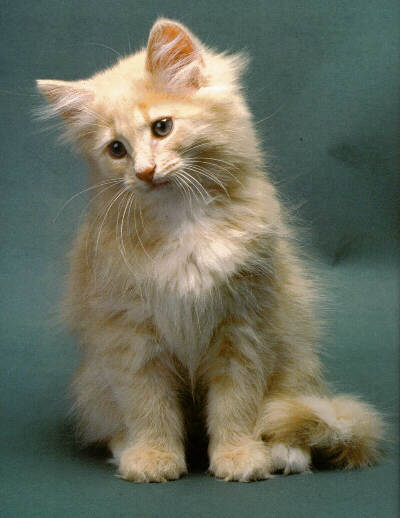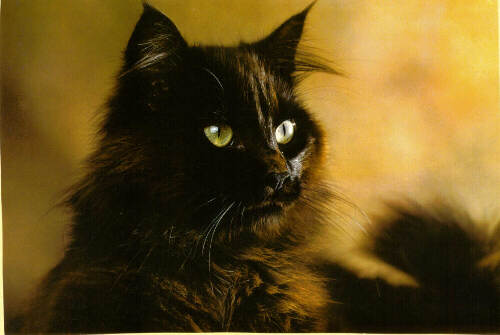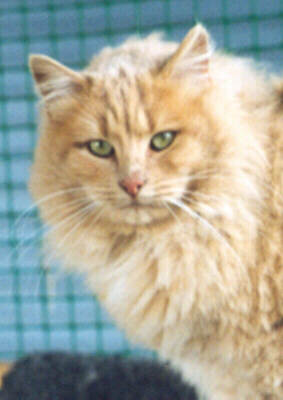
"Supreme Champion Furry Boots SINDRI" in winter coat.
He is shown as a kitten lower down on the page.
The book explains all the cat coat and eye colors and other basic genetics,
with the help of a bookmark so you do not have to memorise a bunch of gene
codes as you read. (Every gene has a unique internationally accepted
abbreviation, so that you know what gene it is, in any country, in any
language.)
The book also advises on the selection of mates so that each
parent complements the other to reinforce good features, and overcome
poor ones. Unique questionnaire charts and color cross-reference charts,
make this easy to do in a special breeder's section.
If you would like to order
"Cat Genetics - What will the kittens look like?"
here is how: Send orders to Furry Boots, at
P O Box 4703, Spokane WA, 99220-0703, USA.
Payment is accepted by check or moneyorder within the USA, or by International post office money order in US dollars from Canada
or by Western Union Transfer or other international check (bank draft) or international money order in US funds which includes any exchange costs from other countries.
Price is US $43.50 plus postage and handling.
USA postage and handling is $7.50; international postage and handling on request.
Payable to Furry Boots or to Irene de Villiers.
(Wired funds not accepted due to exhorbitant bank charges.)
I'll send the book within a week of receipt of order. Where available, I make use
of the new flatrate priority or global priority system; otherwise I use international airmail.

As to my followup second book, here
I want to go a whole step further, to provide for healthy breeding with
improvement of type, applying known genetics principles in a new way.
The intention here is to dispel old myths about inbreeding being an acceptable
thing to do "if you know what you are doing" as so many folks have been
taught to believe - and instead, to explain what inbreeding REALLY is,
what causes it, and how and why to avoid it.
Best of all, here is a methos whereby you can improve TYPE without inbreeding!!!
This is practical application of the true genetic facts behind the principle
of avoidance of inbreeding, to achieve health and type at the same time.
Here is a little introduction to my way of thinking on this:
People have long believed that inbreeding "in the right way" will help them improve type, ie show quality. However, most them know that inbreeding deteriorates health. While I have never been a proponent of inbreeding for any reason or excuse at all, there have been no alternative methods offered, by which pedigree breeders of any pet, can improve show type, much less a method which *also* improves health! The time has come to apply the genetic facts and theories, to practical methods of achieving health and type together.
*** I propose here a method to breed better type without inbreeding! ***
Please Note Copyright, by Irene de Villiers.
I am contactable by snailmail at:
P O Box 4703, Spokane WA 99220-0703, USA.
....................................................................................................................................................
 Purry, left, and Loki, center, are an example of a really excellent breeding
pair for both type and health.
Purry, left, and Loki, center, are an example of a really excellent breeding
pair for both type and health.


The picture on the right is of Sindri, a kitten of this mating. He is an improvement over his parents.
Click Here for More FURRY BOOTS Fun:
HOME & FRIGGA - NFC Queen
SINDRI - Cream Cameo NFC Stud
LOKI & ODIN - black NFC studs
MINERVA & PURRY - Two NFC Queens
FURRY BOOTS KITTENS - Past/Current